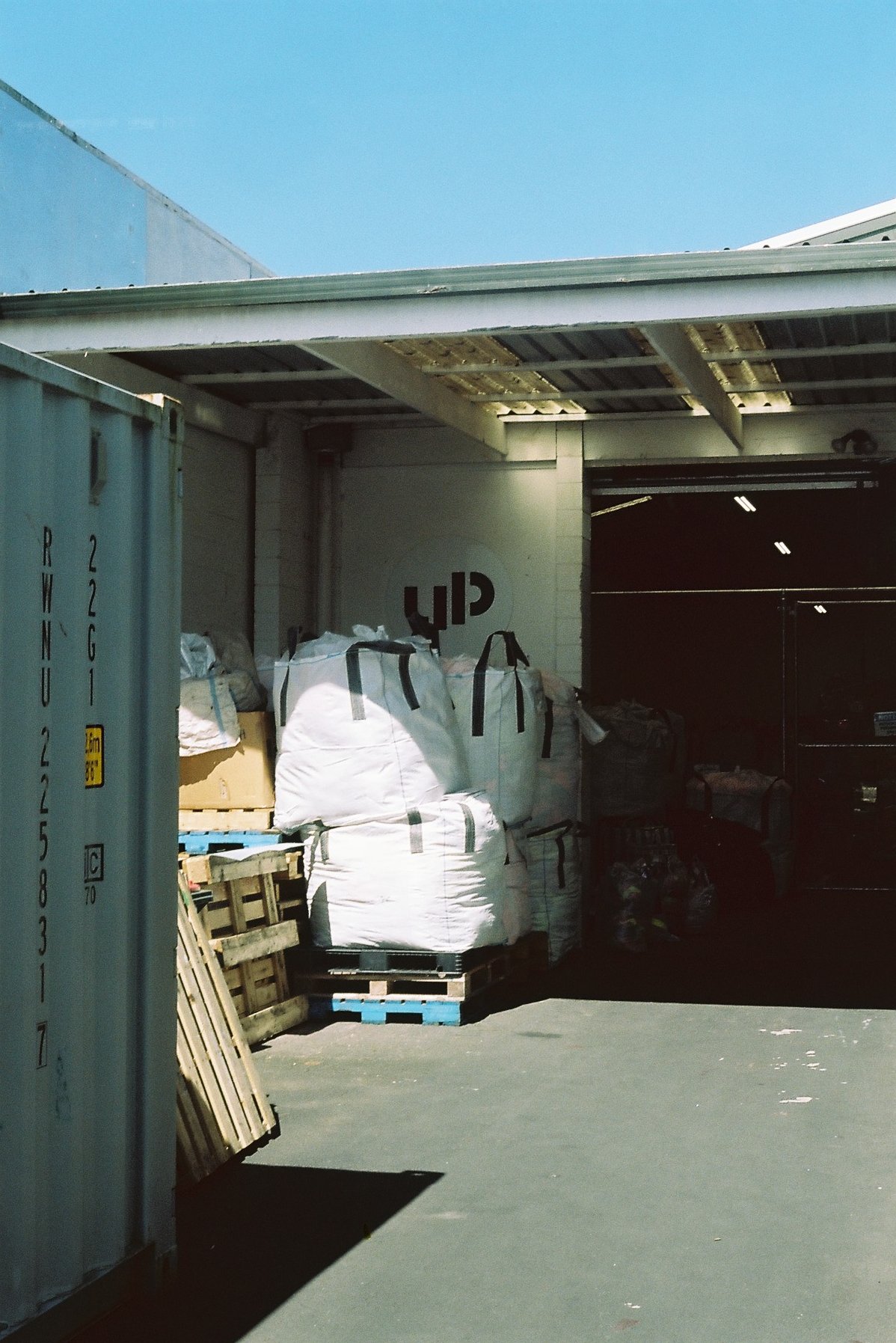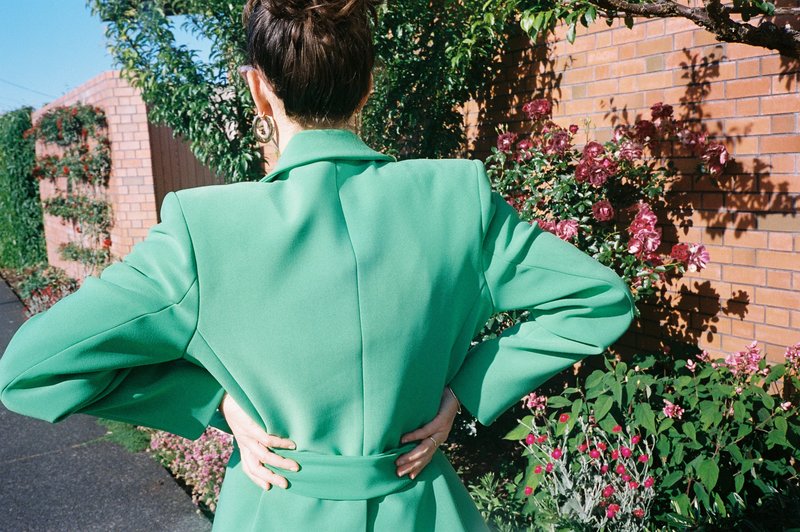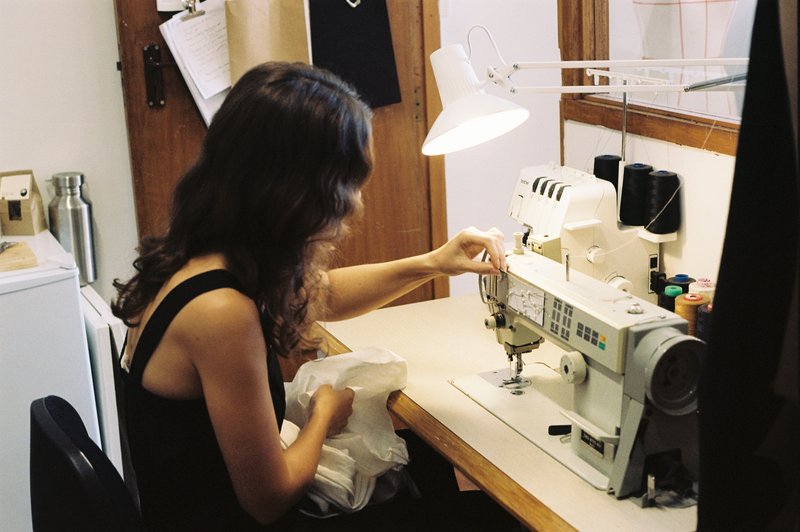Over the last two years, what started as a genuine curiosity about waste and hyper-consumerism led to a deeper interrogation into the endless stream of trash that powers a consumer market in which we all (to varying degrees) participate. I work as a sustainability consultant for Ecoware, which sells compostable packaging and co-chair Common alongside its founder and dear friend Charli Cox to dress people through what we call a community clothing exchange. But that access to clothing is made possible primarily by public donations. There are parallels between the two. No one wants to pay for waste management. Taxpayers pay for it, though. These are my opinions, and I thought it would be interesting to share some recent research and figures that reaffirm that trying to keep things out of landfills—and actually not producing (and consuming) these things in the first place is the only viable solution. I hope this article will leave you asking questions.
Globally, 80% of all clothing produced ends up in incinerators or landfill. (Global Fashion Agenda, 2017). Fashion’s waste problem is at a tipping point. Moving to a circular production is a huge issue for the industry. For clothing to be fully circular, we’re reliant on the recycling infrastructure to catch up and improve. Many fibres can’t yet be broken down and recycled. And reverse logistics costs more. There are parallels to the plastics issues, the only difference is we are starting to see legislation impacting single-use plastics but not other areas of waste—like textiles.
How much does clothing contribute to waste?
When there are 100 billion garments produced year after year, 60% of which are plastic, the immediate and future impacts are alarming. Fast fashion remains the industry’s biggest challenge. In the past 15 years, global clothing production has doubled. People (generally) are buying more low-quality items than ever before, but we’re using them 40% less. Many people don’t understand that you can’t throw garments away—87% of garments are landfilled or burned, and less than 1% are recycled (Ellen MacArthur Foundation).
In Aotearoa, New Zealand, over 380,000 tonnes of textile products are imported annually, and around 180,000 tonnes of that ends up landfilled (reference 1news, 2023). This research presented by UsedFULLY also finds that 4,242 tonnes of textiles are exported overseas annually, where these garments contribute to environmental destruction and reseller debt. As more retailers and resellers collect used clothing to resell and repair, they’re also sending vast quantities to landfills. Recent Sapere’s analysis also finds that in Auckland, Tāmaki Makaurau alone, annually, a total of 31,977 tonnes of textiles enter the market via imports and local manufacturing and 16,952 tonnes are landfilled. Of that, op shops landfilled 8.7 tonnes. Consumers, via op-shops, are the largest source of fashion clothing sent to landfill.
Another 3.1 tonnes of garments are landfilled before sale or wear.
Somewhere between 10% and 40% of garments produced are never sold. I will not cover it here because this piece published by The Guardian has, but the fashion industry has overproduction built into the business model. When I started working with Charli with Common, we believed that we could help the fashion industry recognise the opportunities for these unsold textiles, providing low-resistance pathways for brand owners and retailers to get involved in our work. Two years on, we still struggle to acquire brand donations. I always say that as a brand, [your] customers are donating to us, so why not join them? But we have seen the boxes piled high at a textile recycling facility—brands are downcycling grade A stock. And the current tax laws incentivise it. And landfilling.
Textiles represent 5% of materials in class 1 landfills, contributing to 10% of emissions in 2022—a waste stream where source reduction and diversion options are currently either limited or non-existent. Our vision is to make practical sustainability possible for everyone. Textiles contributed to 10% of emissions in 2022, yet the Auckland Council draft waste management and minimisation plan 2024 does not mention textiles or clothing. Scion’s recent data confirmed that our clothing is a major source of microplastic pollution, in that 87% of the microplastics polluting Tāmaki Makaurau, Auckland waterways came from synthetic textiles.
Counting carbon emissions and climate impacts
Charli and I are partners of UsedFULLY’s Textile Reuse Programme. We collect data on garments received and delivered to charitable organisations. These counts are used to report our effective kgCO²e impact—the carbon we save from being released into the atmosphere by keeping garments in circulation. How transformative would it be for the industry if brands were required to do this? How would your purchases shift if you knew how much water and greenhouse gas emissions these brands were creating? If brands were mandated to disclose the volume of products put on the market and landfilling and destruction under the guise of ‘textile recycling’, landfilling was prohibited. I think first, brands would forecast more realistically and reduce production and second, if there were tax incentives (like there are in Australia), you would see brands start to donate unsold stock. Eliminating excessive workforce and inventory makes profit possible even during periods of slow growth. Perhaps legislators could dare us to imagine economies where overconsumption and its associated waste were curbed by mandatory Environmental Social Governance (ESG) reporting and at the same time, force brands to operate better. Textile waste is a clear example of inefficiency.

Thoughts on upcycling
Upcycling is not scalable. And it is not a viable solution, albeit part of a broader strategy. When done well, it can show examples of what things could be. People do throw clothing in the red bin. If you read our September essay published on Substack, you will know that defining and assigning value is complex. Yes, upcycling can teach people how to look at things differently and look for possibilities, but upcycling needs to exist within a much broader reverse logistics system where materials are recovered and processed at scale and sorted for appropriate streams. However, I wanted to address upcycling; it plays a very small but important part in shifting value and waste perceptions.
Australians send 200,000 tonnes of clothing, just clothing not textiles, to landfill annually. Recent research by RMIT University found that one in three people will put clothing in the red bin. Their research findings concluded Australians buy too much clothing and then they are unsure how to dispose of it. But the fact is, the red bin is currently the correct disposal method. The paper, while referencing the work of resellers and charities, acknowledged that a national programme for collecting unwearable clothing and recycling these garments was required. That is what Seamless should fund.
Read the report, Keeping clothes out of landfill: A landscape study of Australian consumer practices, funded jointly by Kmart Group and the Queensland Government Department of Environment, Science and Innovation. DOI: 10.25439/rmt.27092239
Seamless
Seamless is Australia’s first National Clothing Stewardship Scheme aligning industry with the government’s circular economy and carbon emissions reduction targets. It includes all new clothing imported into or manufactured in Australia. The scheme comprises a Financial contribution paid by brand owners, 'stewards,' on each new item of clothing they place on the market. That rate is set to four cents for voluntary membership, and starting this July, the Product Steward Organisation will become fully operational. Environmental Minister Tanya Plibersek announced that the fashion industry had until July 4th, 2023, to sign up or face regulation directly. The intent focus (when I attended the webinar on the topic late last year) was on recirculation as a priority and recycling as an option for unwearable clothing. The Product Steward Organisation stated it would work alongside the charitable reuse sector, enabling increased capacity, improved sorting methods and technologies investigated and piloted. This paper has a diagram showing that three-quarters of textiles sent to clothing charities end up in landfill. And this is just NSW. I continue to follow the scheme developments closely but not a lot has occurred so far. I will leave the CEO’s six months reflection here. One suggestion is that the 4 cents per garment on the market is nowhere near enough.
Consumers, via op-shops, are the largest source of clothing sent to landfill
On LinkedIn, I saw this post announcing that the Queensland Government is supporting Circular Economy infrastructure by funding Salvos Stores and The Salvation Army to establish a textile recycling plant in Carole Park, QLD. The capacities stated were to ‘sort textiles, remove buttons and zippers, and customise end products for recycling.’ Given what I knew about op-shop (Salvos included) in Aotearoa landfilling 8.7 tonnes of clothing donations annually, the post suggested that the remainder of textiles that were not customisable would be landfilled or exported. The founder of BlockTexx questioned why, when viable solutions existed for recycling in Australia (his company and Upparel) that there had not been the engagement to explore the possibilities. Through Common, Charli and I had legacy charity shops contacting us to take their unsellable product. They knew we were (at the time) recycling, but we paid for that. I won’t go into why we cannot recycle anymore (though we receive a minimal amount of unsellable donations). But when we do, we use take-back schemes. And you know what happens to those collections? As this investigation found overseas, a proportion is sent to charities and op-shops because the textile recycler does not want to pay to sort and process these garments. Again, I know because I have sorted through these collections.
Interestingly, while researching for open waste minimisation grants, I found that the councils pay charities to landfill clothing. Yes. In South Australia, this grant funded landfill fees for the charitable sector. The Salvos received $69,534 to partially cover their landfill fees. That money should be going to organisations like BlockTexx and Upparel or supporting smaller players like Guy Dempster, who recycles Australian textile waste into spun yarn in collaboration with a network of international and local textile mills. Their mission is to ensure waste traceability and establish fibre recovery facilities locally in Australia by establishing a mill in North West Tasmania. Not a landfill owner.
Why op shops are full of trash now
In a recent Substack issue, I shared this video, ‘It's Not Just Shein: Why Are ALL Your Clothes Worse Now?’ which explains what we all expected. Because mass production is based on stable demand and high volumes of standard (or substandard) product, profits are able to increase due to ever-reducing labour and resource input costs. But there are costs. In his book ‘Creating Value for Customers: Designing and Implementing a Total Corporate Strategy’, Band states how pursuing a mass production process instead of a customer-satisfying process would result in problems. These warnings were largely ignored. There are of course trade-offs. High quality and low cost was an impossible combination and any reductions in human labour or shifting to cheaper materials (synthetics primarily) would produce societal costs, not corporate costs. And we’re paying for these profit-maximising business decisions now—with microplastics in our water and food supply. Waste needs to become less of a political issue and start to become a human health issue.
Initially, op shops existed to serve those who did not have the financial means to purchase new quality clothing—which was, at a point in time, pre-1990s, available to everyday people. As one Reddit user pointed out, they are ‘Just a free way of [people] getting rid of their junk’. Anything good in op shops was taken by the social media resellers who are seeking to capitalise on charity store donations—because, capitalism. And all that did was disenfranchise those who needed a pure wool sweater for $20. Resellers have gentrified second-hand; they are not even competing with fast fashion. So while it is not viable for the fashion industry to continue to operate the way it does today, it is equally not feasible for the vast majority of the resale market and those who operate within it to use the same playbook.
Arguably the role of thrift stores has shifted significantly from what it was pre 1990s, the extend to which they serve their intended community is negligible. They are the intermediary between the mass consumer and the landfill. This is why late 2023, Charli and I implemented drop-off fees for donated garments. If there is no financial component, people will not see value in the service you provide. We want people to buy into what it is we are trying to achieve. You can put your clothes in the red bin. We won’t pay to do it for you. But if you want to envision a society where we are working within circular principles, effectively redistributing resources, supporting resale, shifting shopper behaviour and reducing the climate impacts of building out your wardrobe, you can buy a clear out kit for $19.

Making fashion circular and the growth of consignment
While selling used items online isn’t a new concept (eBay launched in 1995), The Real Real, Vestiaire Collective, HEWI (Hardly Ever Worn It) and other luxury resale platforms redefined access and ultimately created a collector culture. This movement to recirculate arrived at the intersection of increasing awareness for several issues within the industry. One of the most obvious is the incomprehensible pace at which clothing is being produced; there is too much cheap product. Vestiaire Collective’s Instagram 'swap this for that’ posts highlight the fact that a circular system is not going to operate with high street brands or worse.
When Vestiaire Collective announced they would ban fast fashion, the move raised questions over how fast fashion should be treated by circular business models. They believe fast fashion has no value and even less in resale. And they refused to host it on their site. Vestiaire Collective continues working with a third-party agency to create a set of criteria that will help eradicate low product quality and poor working conditions to lower its overall carbon footprint. These consignment sites make the most sense. They are peer-to-peer, which is inherently more prosocial. You’re helping another individual make cash to reinvest in their wardrobe or buy flights to visit a friend versus simply providing profits for someone who is now running a business.
What are the regulatory solutions?
People don't like to talk about the waste, not really, not the charity sector or resellers, not the brands and retailers landfilling unsold stock but it is happening. Last week I spent several hours reading over the proposed options for addressing packaging plastic waste in Australia. The likely option is an Extended Producer Scheme. This is the only solution that will achieve the desired outcome that Australia’s Minister for Environment and Water Tanya Plibersek wants— less clothing on the market. This would mean that fees would be applied to every garment entering the country, imported—or purchased online, with eco-modulated fees to incentivise better materials for example.
Overseas sellers like Shein must register for tax collection purposes. Therefore it would be possible to apply proportionately higher fees (in addition to taxes) to make their products less cheap for their customers. Import bans are an option. India briefly banned Shein in 2020. It is unreasonable for people to think it is okay for billion-dollar corporations to violate human and environmental rights to sell $10 dresses to Australians who produce disproportionate volumes of textile waste without contributing to the management of this waste.
Recycling minimums are also being enforced that will work to create markets for recycled materials. France is setting the tone for enforcing minimum recycled content, supporting circular economy principles enforced by legislation, producer responsibility schemes, and financial incentives via its AGEC Law. This is extending influence to other countries and the European Union (EU) more broadly. Mandating sustainability reporting is another approach. If brands had to declare what they imported, sold, did not sell, landfilled or destroyed under the guise of recycling etc, you would see people wasting less, and producing less.
In our writing, we always come back to the point of overproduction, overconsumption, and waste. Our systems are exploitative. The concentration of wealth occurs in tandem with reduced protections for people and our environment. These are social and environmental injustices. Mcdonalds' has educated people on what value is. People need to unlearn. Value is not about more for less money. That is the greatest challenge. We have to (and anyone else wanting to see a shift) re-educate. And yes, there will be opportunities (including financial opportunities) for those working within planetary boundaries and creating products within a circular system with actual value.
I will end with this because there is no argument here. As someone who studied cancer pathology and biology at university, there was that resonance that perhaps others might not fully understand. Fast fashion requires the exploitation of resources and people to exist. They rely on the extraction of infinite resources in a finite system. In biology, that is cancer.
“Growth for the sake of growth is the ideology of the cancer cell.” - Edward Abbey, The Journey Home: Some Words in Defense of the American West (ecological philosopher).




